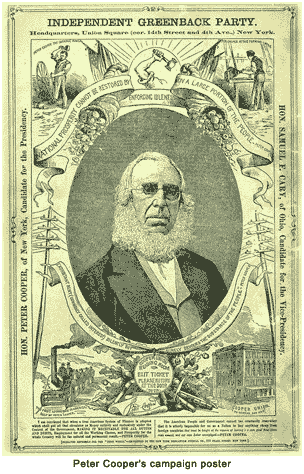One of the leading public issues of the immediate postwar period was related to the nation’s currency.
The heart of the debate centered on an action the government had taken to fund the Union effort in the Civil War. Between 1862 and 1865, the government printing presses issued $450 million in greenbacks, paper notes that were not backed by reserves of specie.
 Simply stated, the agrarian and debtor interests wanted to keep the greenbacks in circulation and even urged that more be printed. Such a move would likely generate inflation, which was regarded as a favorable event since it would be easier to pay of debts with “cheap” money. From the political side, this point of view was adopted by many Democrats who floated a scheme to redeem war bonds in greenbacks.
The Republicans, as the representatives of the wealthy creditor interests, wanted the greenbacks removed from circulation and the return to a gold-backed currency. This would halt inflation and assure that they would be repaid in hard money.
Tensions were heightened during the depression that followed the Panic of 1873. Farmers and debtors bore the brunt of the economic distress and issued calls for the printing of additional greenbacks and the unlimited coinage of silver. These calls for action were transformed into a political movement and, in 1876, into a political party. The National Greenback Party took up the greenback refrain and pledged to fight the Specie Resumption Act (1875), as well. Peter Cooper received the group’s presidential nomination, but polled only about 80,000 votes.
In 1878, a congressional election year, the organization changed its name to the Greenback-Labor Party and supplemented its membership by taking in workers. They received more than one million votes nationwide and elected 14 party members to Congress.
In the Election of 1880, the Greenback-Labor Party nominated General James B. Weaver on a platform designed to further broaden its appeal. Such issues as women's suffrage, federal regulation of interstate commerce and a graduated income tax were included. Weaver polled only 300,000 votes, a clear demonstration that the greenback issue had passed its prime. The times had changed: Resumption had been a success, the depression had ended and the Bland-Allison Act had concentrated attention on the emerging issue of the coinage of silver.
Despite its lack of success, the party made a last stab at the presidency, nominating Benjamin F. Butler in the Election of 1884. His showing was dismal and the party disbanded. Its members drifted off to the Union Labor Party and the Populist Party.
The Greenback Party made an important contribution to American politics by demonstrating the monetary policy could and should be part of the national debate.
Simply stated, the agrarian and debtor interests wanted to keep the greenbacks in circulation and even urged that more be printed. Such a move would likely generate inflation, which was regarded as a favorable event since it would be easier to pay of debts with “cheap” money. From the political side, this point of view was adopted by many Democrats who floated a scheme to redeem war bonds in greenbacks.
The Republicans, as the representatives of the wealthy creditor interests, wanted the greenbacks removed from circulation and the return to a gold-backed currency. This would halt inflation and assure that they would be repaid in hard money.
Tensions were heightened during the depression that followed the Panic of 1873. Farmers and debtors bore the brunt of the economic distress and issued calls for the printing of additional greenbacks and the unlimited coinage of silver. These calls for action were transformed into a political movement and, in 1876, into a political party. The National Greenback Party took up the greenback refrain and pledged to fight the Specie Resumption Act (1875), as well. Peter Cooper received the group’s presidential nomination, but polled only about 80,000 votes.
In 1878, a congressional election year, the organization changed its name to the Greenback-Labor Party and supplemented its membership by taking in workers. They received more than one million votes nationwide and elected 14 party members to Congress.
In the Election of 1880, the Greenback-Labor Party nominated General James B. Weaver on a platform designed to further broaden its appeal. Such issues as women's suffrage, federal regulation of interstate commerce and a graduated income tax were included. Weaver polled only 300,000 votes, a clear demonstration that the greenback issue had passed its prime. The times had changed: Resumption had been a success, the depression had ended and the Bland-Allison Act had concentrated attention on the emerging issue of the coinage of silver.
Despite its lack of success, the party made a last stab at the presidency, nominating Benjamin F. Butler in the Election of 1884. His showing was dismal and the party disbanded. Its members drifted off to the Union Labor Party and the Populist Party.
The Greenback Party made an important contribution to American politics by demonstrating the monetary policy could and should be part of the national debate.